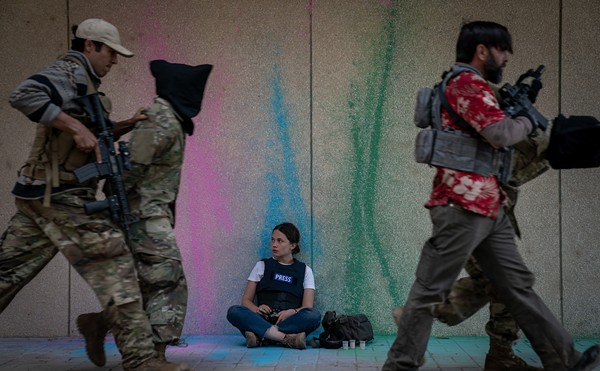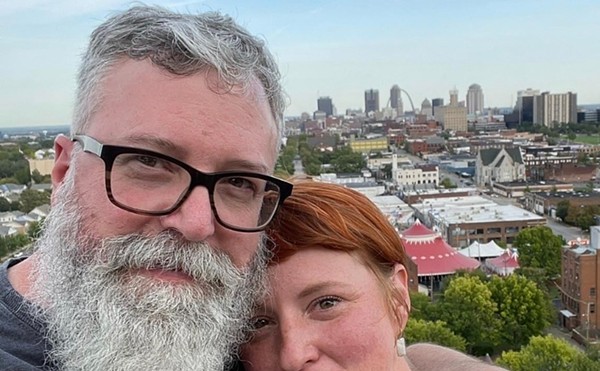The black-and-white newsreel footage, in all its grainy glory, was shot 60 years ago in the Missouri Bootheel, when dirt-poor people lived on very rich land. It is a paradox that continues even today in the seven-county region that produces almost all of the state's cotton crop.
Premiering at Webster University on Saturday, April 17, Oh Freedom After While, which takes its name from a line in a Negro spiritual, retraces the struggles of the farm laborers in Southeast Missouri during the Great Depression. The documentary focuses on an integrated protest movement that galvanized under the leadership of the Rev. Owen Whitfield, a Baptist preacher and an organizer for the Southern Tenant Farmers Union (STFU).
To gain public recognition of their impoverished existence, Whitfield convinced a legion of sharecroppers to move their families and all their belongings onto the roadsides of Southeast Missouri in the middle of winter. On the morning of Jan. 10, 1939, the homeless squatters had grown to more than a thousand, their scattered ranks stretching for miles along U.S. Highways 60 and 61.
The protest represented an unprecedented show of solidarity between black and white farm workers. By this measure alone, it posed a serious threat to the status quo. Whitfield's bold strategy also embraced another innovative method of seeking change: It used mass media to advance a cause. Photographs and newsreels of destitute men, women and children were disseminated nationwide.
In addition, the sharecroppers had taken a labor-union tactic -- the sit-down strike -- and applied it to their own circumstances. But instead of seizing the means of production by taking over a factory, they abandoned the relative security of the plantation system in a public display of defiance. Whitfield fled to St. Louis before the demonstration to avoid being lynched, but he had planned well by designating a leader for each of the 13 groups of squatters.
Government officials were initially caught off guard, but within a few days the state health commissioner had inspected the camps and ruled that they posed a public-health threat. Using this excuse, county sheriffs, highway patrolmen and specially deputized citizens swiftly evacuated the protesters, in some instances by force or intimidation, to less conspicuous locations.
Some of the homeless took refuge at a nearby Baptist church; others were confined in dance halls or sequestered behind a levee. The health commissioner himself called these temporary settlements "concentration camps."
Meanwhile, the cotton planters began to promulgate the theory that the protest had been instigated by outside agitators. The governor and the superintendent of the Missouri Highway Patrol agreed. In a letter to Secretary of Agriculture Henry A. Wallace, Gov. Lloyd C. Stark alleged that a leftist conspiracy existed at the highest levels of the federal government. He blamed the demonstration on "certain un-American and communistic practices, which ... can be traced directly to certain employees of the Farm Security Administration (FSA)."
In a sense, the governor was right. As a result of the economic implosion brought on by the Great Depression, the federal government had been forced to place moderate socialistic restraints on capitalism, including price controls for agricultural commodities. It was far from a perfect system, however.
Under the Agricultural Adjustment Act, the Roosevelt administration paid landowners not to grow cotton as a means of stabilizing the market. According to the law, members of the gentry were supposed to pass a percentage of the subsidy to their sharecroppers and tenant farmers. Instead, they often kept all of the money for themselves by evicting their tenants and hiring day laborers to do the same work. Many of the property owners were absentee landlords, insurance companies and speculators who had no direct stake in agriculture. Those plantation owners who did cultivate the land frequently used the government payments to buy tractors and other farm implements, which further eliminated their need for labor. From the sharecroppers' perspective, the corruption of the New Deal program amounted to a nascent form of corporate welfare, which served only to prop up the tottering plantation hierarchy of the postbellum South.
H.L. Mitchell and Clay East founded the STFU in Tyronza, Ark., in April 1934 by banding together a handful of black and white sharecroppers. By the time Whitfield organized the Bootheel demonstration in 1939, the union had grown to 35,000 members, most of whom lived in the cotton-belt states of Arkansas, Tennessee, Mississippi, Oklahoma and Missouri. In 1937, the union became affiliated with the Congress of Industrial Organizations (CIO), which included many communist organizers.
When the STFU joined the CIO, it became a part of the United Cannery Agricultural Packing and Allied Workers of America. This eventually led to a dispute between Mitchell, the STFU leader, and communists within the latter union. He accused the communists of using the St. Louis Committee for the Rehabilitation of the Sharecroppers -- a support group founded by Fannie Cook, a University City-based writer -- to stir up dissension within the STFU. The conflict ultimately forced Whitfield out of the STFU.
But he still remained loyal to the sharecroppers. The St. Louis committee raised enough money for the homeless sharecroppers to buy 93 acres of land in Butler County, Mo., at the town of Harviell, 15 miles southwest of Poplar Bluff. On June 17, 1939, more than six months after the demonstration, 80 black and 15 white families moved to the site. Whitfield and his family were among those who homesteaded the land. The sharecroppers received assistance from the FSA and the American Friends Service Committee, a Quaker-affiliated organization. The community, which came to be known as Cropperville, lasted for about 10 years.
Oh Freedom After While premieres at 7:30 p.m. Saturday, April 17, at Webster University's Winifred Moore Auditorium, 470 E. Lockwood. Following the screening, director Steven J. Ross, scriptwriter Candace O'Connor and co-producer Lynn Rubright lead a discussion of the film.





